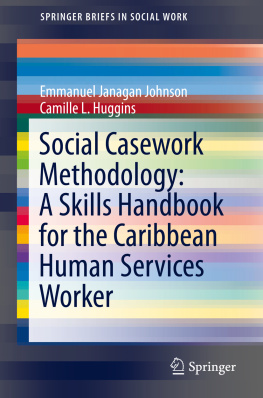First published in 1964 by
Routledge
Reprinted 1998, 1999 (Twice) by
Routledge
2 Park Square, Milton Park, Abingdon, Oxon, OX14 4RN
711 Third Avenue. New York, NY 10017
First published in paperback 2011
1964 Noel Timms
All rights reserved. No part of this book may be reprinted or reproduced or utilized in any form or by any electronic, mechanical, or other means, now known or hereafter invented, including photocopying and recording, or in any information storage or retrieval system, without permission in writing from the publishers.
The publishers have made every effort to contact authors/copyright holders of the works reprinted in The International Library of Sociology. This has not been possible in every case, however, and we would welcome correspondence from those individuals/companies we have been unable to trace.
British Library Cataloguing in Publication Data
A CIP catalogue record for this book
is available from the British Library
Social Casework
ISBN13: 978-0-415-17721-4 (hbk)
ISBN13: 978-0-415-51041-7 (pbk)
Public Policy, Welfare and Social Work: 18 Volumes
ISBN13: 978-0-415-17831-0
The International Library of Sociology: 274 Volumes
ISBN13: 978-0-415-17838-9
Publishers Note
The publisher has gone to great lengths to ensure the quality of this reprint but points out that some imperfections in the original may be apparent
ACKNOWLEDGEMENTS
I WOULD like to thank those social workers in probation, child care and almoning, those psychiatric social workers and family caseworkers who have allowed me to use extracts from their case material. It has been decided, in consultation with these workers, that no specific acknowledgements should be made so that the secrecy of the records would be safeguarded as fully as possible. The content of the book will, however, signify the extent of my indebtedness.
These workers come from the main branches of social work and from both sexes! Some professional groups of social workers are still predominantly female, but an increasing number of men are entering the profession. Consequently, I have decided in the text to abandon the usual convention whereby the caseworker always plays she to the clients he.
Part of has already appeared in Blackfriars December 1962. I am grateful to the Editor for allowing me to use this material in the present work.
Chapter One
THE CASEWORKER AND THE AGENCY
INTRODUCTION
THE need for a general textbook of British social casework practice is widely acknowledged in this country and the present work aims at satisfying certain aspects of this need. This is a time of fruitful and even exciting change in social casework and there is room for several different kinds of book on the subject, though the temptation perhaps is to try to encompass the range of possibility in one volume. In this book an attempt will be made to describe some of the main problems facing caseworkers as they try both to help their clients and to theorize about their methods and objectives; to discern the knowledge they use and apply; and to appraise the significance of the social agencies in which they work. The intention is not to present and justify an overall categorization of the casework process, for example, as treatment but to explore casework operations on an eclectic basis, using as pivots in the discussion ideas of human relationships and of agency function.
British social workers have in the past relied heavily on American writings on social casework. In recent years the balance has been somewhat redressed by the production of original work in this country, but it remains true that our range is neither as extensive nor as comprehensive as the American. This is to be regretted. Obviously some aspects of social casework will be applicable in many countries and there is no necessity for each society to devise a completely fresh idea of casework for its own use. There is a great deal of fruitful thought in American work that can be assimilated by British social workers towards the solution of their theoretical and practical problems. No country needs to look constantly within its own boundaries for a unique inspiration on every topic. Such an insular approach is patently absurd. Equally mistaken, however, is the view that particular traditions, particular ways of making arrangements in a society are readily exportable and that they can be adopted by any other nation without translation or modification in the light of their own experiences.
This view is sometimes inflated into a general objection to American work on the grounds that its theorizing and practice are the product of a culture very different from our own. Exponents of this viewpoint seldom describe what they hold to be the essential differences. A sounder basis on which to judge the usefulness of American (or any other) ideas on social casework is provided by comparing their theorizing with our own social work experience. Social casework began in Great Britain, but despite the creative writing of individuals in the late nineteenth century and in more recent times, we have seldom paused to consider and appraise our own total experience in this field. Such a task is important at the present time, not simply because we can then assess the differences between American experience and our own, but also because we can be confident in our own contribution to a general view of the theory and practice of social casework.










